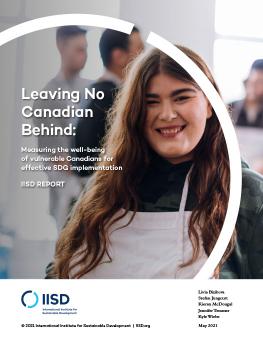
Leaving No Canadian Behind
Measuring the well-being of vulnerable Canadians for effective SDG implementation
By committing to the 2030 Agenda and the Sustainable Development Goals (SDGs), Canada also pledged to "leave no one behind" in its development efforts. This will only be possible if we improve how we monitor the well-being of the country's most marginalized groups.
-
Canada should adopt a multi-tiered #data4SDGs approach where organizations that work with marginalized people gather and govern #data to measure the state of their well-being.
-
Bottom-up implementation of the #SDGs requires bottom-up measurement. Countries like Canada should aim to mobilize disaggregated data on groups that are inherently difficult to measure.
-
Tracking the progress of marginalized groups toward the #SDGs creates new #data needs, including the need to join up data from different sources that developed independently of each other.
While most Canadians enjoy a high standard of living, numerous groups are being left behind in the country. A low income, for example, hampers almost 15% of Canadian households. The groups being left behind are very diverse—and include Indigenous Peoples (First Nations, Métis, and Inuit), recent and elderly immigrants, people with disabilities, lone-parent households, and members of the LGBTQ* community.
The factors that burden these groups are similarly diverse and the challenges for measuring their well-being relate to the empowering them in the data collection process as well as the specific risk factors they face. After all, marginalized groups may have different perceptions, values, and priorities, leading to diverging perceptions of their situation and the measures needed to improve their situation.
Leaving No Canadian Behind uses a combination of literature research, systematic scans, interviews, and data analysis to explore:
- measurement challenges related to leaving no one behind
- current international practices
- what is known about vulnerable populations in Canada
- available complementary data sources
- the role of data interoperability
The report shows there are several opportunities to provide space and support for bottom-up community-driven measurement that complements existing indicator frameworks and data—all while putting marginalized groups in charge of how their needs are measured.
You might also be interested in
Citizen-Generated Data: Data by people, for people
Citizen-generated data complement official data and provide a necessary context for decision-makers to address those left behind, suffering from data marginalization and the outright invisible in national statistics.
What Is Alternative Data and How Can It Help Efforts to Leave No One Behind?
Official statistics and measures of poverty do not fully capture the causes of marginalization and how they intersect and interact. The 2030 Agenda is catalyzing a shift in how the world thinks about data and the use of "non-official data sources" to better reflect the needs of the most marginalized.
Disparities in COVID Impacts Underline the Importance of Racialized Data to Understand and Address Systemic Racism
Racialized data on risk exposure and health impacts can help understand inequities in COVID-19 impact and support preventive policy decisions, but collection to date is haphazard.
Not Just Who, But Where: The need for geospatial data to achieve the Sustainable Development Goals
To advance the 2030 Agenda, the availability of geospatial data allows us to know where marginalized people are located and make the evidence-based decisions required to make sure they are no longer left behind.